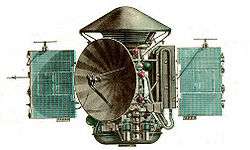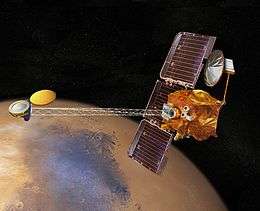Yinghuo-1
| Mission type | Mars orbiter |
|---|---|
| Operator | CNSA |
| Mission duration |
1 year in Mars orbit (planned) Never departed Earth orbit |
| Spacecraft properties | |
| Launch mass | 115 kilograms (254 lb)[1] |
| Dimensions | 750mm x 750mm x 650mm (stowed)[1] |
| Power | Solar array |
| Start of mission | |
| Launch date | 8 November 2011, 20:16:03 UTC[2][3][4] |
| Rocket | Zenit-2M |
| Launch site | Baikonur 45/1 |
| Deployed from | Fobos-Grunt (planned) |
| End of mission | |
| Decay date | 15 January 2012[5] |
| Orbital parameters | |
| Reference system |
Areocentric (planned) Geocentric (achieved) |
| Regime | Low Earth (achieved) |
| Perigee | 800 kilometres (500 mi) (planned) |
| Apogee | 80,000 kilometres (50,000 mi) (planned) |
| Inclination | 5 degrees (planned) |
| Period | 3 days (planned) |
Yinghuo-1 was a Chinese Mars-exploration space probe, intended to be the first Chinese spacecraft to explore Mars. It was launched from Baikonur Cosmodrome, Kazakhstan, on 8 November 2011, along with the Russian Fobos-Grunt sample return spacecraft, which was intended to visit Mars' moon Phobos.[2][6] The 115-kg (250-lb) Yinghuo-1 probe was intended by the CNSA to orbit Mars for about two years,[1] studying the planet's surface, atmosphere, ionosphere and magnetic field.[7] Shortly after launch, Fobos-Grunt was expected to perform two burns to depart Earth orbit bound for Mars. However, these burns did not take place, leaving both probes stranded in orbit.[8] On 17 November 2011, Chinese state media reported that Yinghuo-1 had been declared lost by the CNSA.[9] After a period of orbital decay, Yinghuo-1 and Fobos-Grunt underwent destructive re-entry on 15 January 2012, finally disintegrating over the Pacific Ocean.[5][10]
Name
Yinghuo-1's name (simplified Chinese: 萤火; traditional Chinese: 螢火; pinyin: yínghuǒ – firefly, literally "luminous fire") was a tribute to the near-homophone yinghuo (simplified Chinese: 荧惑; traditional Chinese: 熒惑; pinyin: yínghuò). This word, a short form of "shimmering planet" (熒惑星), is an ancient Chinese name for Mars.
Background
On 26 March 2007, the director of the China National Space Administration, Sun Laiyan, and the head of the Russian Space Agency, Anatoly Perminov, signed a landmark space co-operation accord, entitled the "Cooperative Agreement between the China National Space Administration and the Russian Space Agency on joint Chinese-Russian exploration of Mars". One stipulation of the agreement was the construction and launch of the Yinghuo probe and its Russian counterpart, Fobos-Grunt.[4]
Instruments and objectives
Yinghuo-1's primary scientific objectives were:
- To conduct detailed investigation of the plasma environment and magnetic field;
- To study Martian ion escape processes and their possible mechanisms;
- To conduct ionosphere occultation measurements between Yinghuo-1 and Fobos-Grunt, focusing on the sub-solar and midnight regions;
- To observe sandstorms on the Martian surface.
The probe's scientific payload consisted of a four primary instrument packages:[11][12]
- A plasma package, consisting of an electron analyzer, ion analyzer and mass spectrometer;
- A fluxgate magnetometer;
- A radio-occultation sounder;
- An optical imaging system, consisting of two cameras with 200 m (660 ft) resolution, allowing high-quality images of the Martian surface to be captured from orbit.
Mission profile

Following its transit to Mars, Yinghuo-1 was planned to separate from Fobos-Grunt in October 2012[13] and enter a 72.8-hour equatorial Martian orbit,[1] with an orbital inclination of approximately 5 degrees. Fobos-Grunt and Yinghuo-1 would have conducted Mars ionosphere occultation experiments together,[14] although Fobos-Grunt's primary objective was to obtain surface samples from the Martian moon Phobos. Yinghuo-1 would have experienced periods of up to 8.8 hours in darkness when its orbit carried it over Mars' nightside; it would have run on reserve power during these periods, as its solar panels would have been unusable without direct sunlight.[1]
Launch processing
On 17 October 2011, the completed Yinghuo-1 satellite arrived at Baikonur Cosmodrome with Fobos-Grunt, beginning payload processing operations in preparation for its November launch.[15]
Launch and orbital burn failure
China's Yinghuo-1 and the Russian Fobos-Grunt spacecraft were launched together aboard a Ukrainian Zenit rocket with a Fregat upper stage from Baikonur Cosmodrome, Kazakhstan, on 8 November 2011.[2][13] Shortly after launch, Fobos-Grunt was expected to perform two burns to depart Earth orbit and begin its journey to Mars. However, these burns did not take place, stranding the two spacecraft in their parking orbit.[16] Despite repeated efforts to contact Fobos-Grunt and rectify the problem, the spacecraft continued to lose altitude.[17] On 17 November, Chinese state media formally declared the Yinghuo-1 probe lost,[9] and Fobos-Grunt's orbit gradually began to decay.
Destructive re-entry
On 14 January 2012, it was reported that Fobos-Grunt and Yinghuo-1 were beginning their final descent into Earth's atmosphere, falling at a rate of several hundred metres per hour from their 147-kilometre (91 mi) orbital altitude.[10] The two spacecraft completed their re-entry and disintegrated over the Pacific Ocean on 15 January.[5]
Specifications
- Length: 0.75 metres (2.5 ft) (excluding solar panels).[18]
- Width: 0.75 metres (2.5 ft).[18]
- Height: 0.6 metres (2.0 ft).[18]
- Mass: 115 kilograms (254 lb).[14]
- Power: 3-axis stabilised, 2×3 section solar array with a full-extended length of 5.6 metres (18 ft), providing average power of 90 W, and peak power of 180 W.[14]
- HGA: 950 mm antenna dish (S-band) with a 12 W transmitter in two frequencies (8.4 and 7.17 GHz) and a data rate between 8 bit/s and 16 kbit/s.[14]
- LGA: 80 bit/s data rate.[14]
See also
References
- 1 2 3 4 5 Lakdawalla, Emily (9 September 2010). "China's Yinghuo-1 Mars Orbiter". The Planetary Society. Retrieved 30 May 2011.
- 1 2 3 "Russia takes aim at Phobos". Nature.com. 4 November 2011. Retrieved 24 April 2013.
- ↑ Запуск станции "Фобос-Грунт" к спутнику Марса отложен до 2011 года (in Russian). РИА Новости. 21 September 2009. Retrieved 21 September 2009.
- 1 2 "Solar System Exploration". Retrieved 12 December 2009.
- 1 2 3 "Phobos-Grunt: Failed Russian Mars Probe Falls to Earth". ABC News, 15 January 2012.
- ↑ "Daring Russian sample return mission to Martian moon Phobos aims for November Liftoff". Universe Today, 2011-10-13. Retrieved 17 October 2011.
- ↑ "Back to Mars: Russian probe to visit red planet – Joint observation". Russia Today, 2011-09-23. Retrieved 17 October 2011.
- ↑ Маршевая двигательная установка станции "Фобос-Грунт" не сработала (in Russian). RIA Novosti. 9 November 2011. Retrieved 20 November 2011.
- 1 2 "Yinghuo Was Worth It". Space Daily, Morris Jones, 17 November 2011. Retrieved 19 November 2011.
- 1 2 "Phobos-Grunt: Failed probe likely to return late Sunday". BBC News, 15 January 2012.
- ↑ "China and Russia join hands to explore Mars". People's Daily Online. 30 May 2007. Retrieved 12 December 2009.
- ↑ "Chapman Conference on the Solar Wind Interaction with Mars" (PDF). San Diego, California. 12 November 2007. Retrieved 12 December 2009.
- 1 2 Zak, Anatoly (7 May 2011). "Phobos-Grunt mission". Russianspaceweb.com. Retrieved 30 May 2011.
- 1 2 3 4 5 "YingHuo-1 – Martian Space Environment Exploration Orbiter" (PDF). Retrieved 20 October 2011.
- ↑ "Phobos-Grunt and Yinghuo-1 arrive at Baikonur Launch Site". Universe Today, 19 October 2011. Retrieved 20 October 2011.
- ↑ Маршевая двигательная установка станции "Фобос-Грунт" не сработала (in Russian). RIA Novosti. 9 November 2011. Retrieved 9 November 2011.
- ↑ "Russia Running Out Of Time, As Mars Mission Seems Destined To Fail". NPR, 11 November 2011. Retrieved 14 November 2011.
- 1 2 3 "China to launch first Mars probe in 2009". Xinhua, 22 May 2007. Retrieved 19 November 2011.
Further reading
- Zheng, Wei; Hsu, Houtse; Zhong, Min; Yun, Meijuan (2011). "China's first-phase Mars Exploration Program: Yinghuo-1 orbiter". Planetary and Space Science. Bibcode:2013P&SS...86..155Z. doi:10.1016/j.pss.2011.02.008.
External links
- Fobos-Grunt at Spacefiles.com. Includes an image of Yinghuo-1.


.jpg)
.jpg)